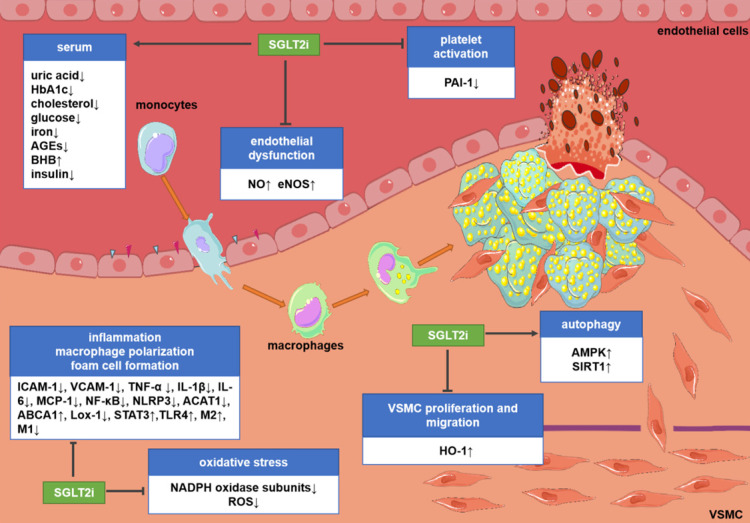Figure 1.
Potential molecular targets of SGLT2i in atherosclerosis. Although the existing evidence is not sufficient to directly prove the anti-atherosclerotic mechanism of action of SGLT2i, some preclinical and clinical studies have revealed some potential mechanisms. SGLT2i may inhibit the progression of atherosclerosis by impacting the levels of related inflammatory factors in the serum, inhibiting endothelial dysfunction, VSMC proliferation and migration, macrophage inflammation, foam cell formation, platelet activation, and oxidative stress and improve autophagy impairment. Abbreviations: ABCA1: ATP-binding cassette transporter A1; ACAT1: acetyl-coenzyme A acetyltransferase 1; AGEs: advanced glycation end-products; AMPK: AMP-activated protein kinase; BHB: β-hydroxybutyrate; HbA1c: glycosylated hemoglobin; eNOS; endothelial nitric oxide synthases; HO-1: hemeoxygenase-1; ICAM-1: intercellular cell adhesion molecule-1; IL-1β: interleukin-1β; IL-6: interleukin-6; Lox-1; lectin-like oxidized low-density lipoprotein receptor-1; M1: M1 macrophages; M2: M2 macrophages; MCP-1: monocyte chemoattractant protein-1; NADPH: nicotinamide adenine dinucleotide phosphate; NF-κB: nuclear factor-κB; NLRP3: nucleotide-binding domain-like receptor protein 3; NO: nitric oxide; PAI-1: plasminogen activator inhibitor-1; ROS: reactive oxygen species; SIRT1: sirtuin-1; STAT3: signal transducer and activator of transcription 3; TLR4: toll-like receptors; TNF-α: tumor necrosis factor-α; VCAM-1: vascular cell adhesion molecule-1.

